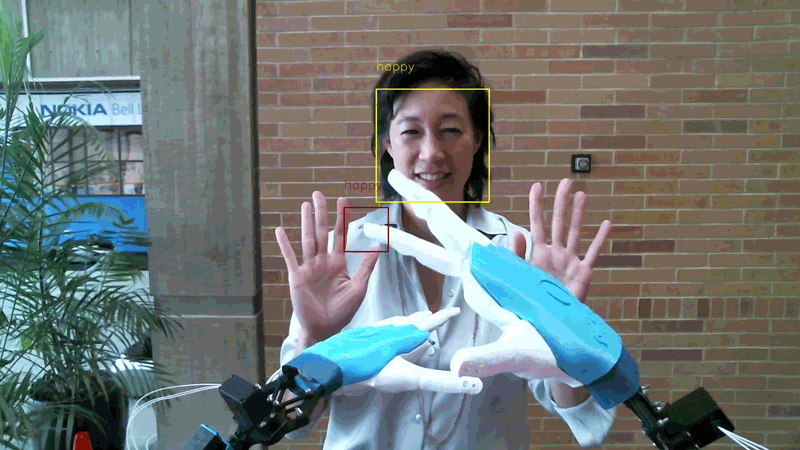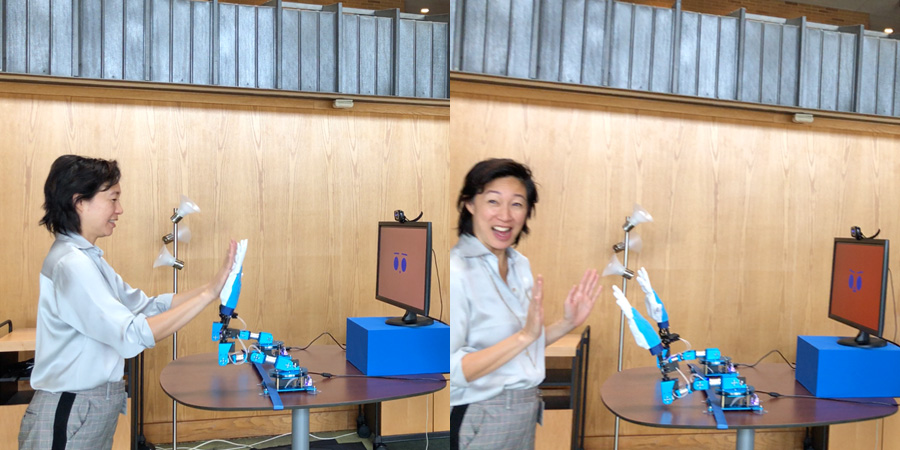
Prototype 1
Exploration into collaboration
Patty, 2019
The way we train and collaborate with social robots tells a story about our potential for compassion and empathy. Patty the robot plays patty cake as a metaphor and poetic gesture for the act of care and emotional knowledge transfer between humans and technology. This prototype shows an example outcome: Patty learns the hand clapping game through trial and error and gains more confidence in its own performance when receiving positive feedback in the form of a smiling trainer.
Built using programmable robotic arms and a rudimentary emotion analysis script which gives a score to the human trainer’s facial features, Patty engages the user in a teacher-student dynamic and feedback loop that is verbal and non-verbal, emotive, experiential, and embodied.

Among the questions I sought to ask with the prototype: in what ways are we continually being trained by technology through the process of training and using it? What is the role of automation in all that “care” encompasses–support, management, control, boundary-setting, active listening, self-sacrifice, self-preservation? How do we interpret the failures of robots? How does the design of their behavior or appearance factor into what failures we choose to forgive?
During the presentation, one of the fingers glued onto the 3D printed hand fell off, causing laughter amongst the audience. The participant in the video professed that this accident endeared the robot to him when he attempted to place the finger back. The response lead me to consider less obvious ways in which human participants can relate and form emotional attachments to robotic companions.
Prototype 2
Interactive installation and narrative sketch
Raising Emotional Robots, 2019
With collaboration from Bell Labs’ and E.A.T. engineers, I created Raising Emotional Robots by appropriating the industrial robot Sawyer. Using the narrative framework of a pair of parents training Sawyer robot to provide companionship for their young daughter, audience members were invited to create their own interpretations of interactions between daughter and robot, which appeared in the following narrative performance. Audience members were invited to train Sawyer to perform gestures representing comfort and caretaking including but not limited to: hugging, patting on the back, and handshakes. These actions were then used in key scenes in the narrative, where the parents attempt to impart their care and concern for their daughter by their actions training the robot.
Prototype 3
Filmic sketch and continuation of narrative
PASSING, 2021
A year after the first COVID lockdown, I previewed a short video called PASSING which tells the story of a child and her family’s struggles in using a robot to provide her companionship and care. In PASSING, a pair of engineers discover the surprising use of a factory robot repurposed for the home. By looking at the actions programmed on its code base, they gradually come to their own conclusions after "seeing" a family's dynamic shifting with the robot's presence and increased usage. In this sketch, I wanted to pose questions around what "passes" as companionship, for whom, and under what circumstances. It's important that the SAWYER robot doesn't quite "pass", or surpass, at the responsibilities to be passed off to it.
A note from Nokia Bell Labs:
As technologists and engineers, we are very excited about all the ways robots can improve our efficiency or perform new tasks, but sometimes we miss that the most important thing a robot can do is interact with a human. We have been working with Fei on this project for a couple of years, investigating what it means to “raise empathic robots,” in Fei’s words. This gives a sense of Fei’s interests and her sensibilities towards the interaction between humans and machines, and it's this sort of thinking that is helping Bell Labs direct its own ideas on better Robot Human Interaction.
In conclusion, despite the amateurish prototypes and half-baked concepts I explored during the two year residency at Bell Labs, I still believe that we can change the future of robotic technology through use. We humanize it through trying to make it work for us—and letting it fail—in the variety of complicated contexts of our lives.